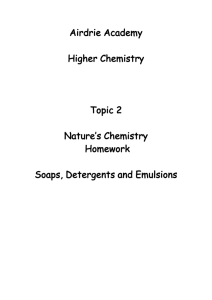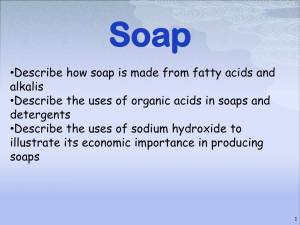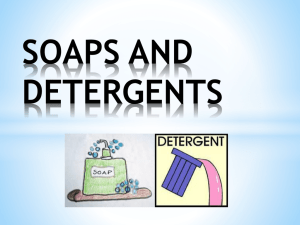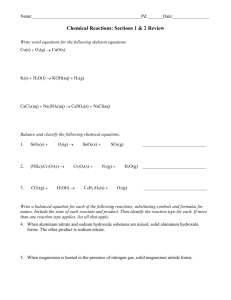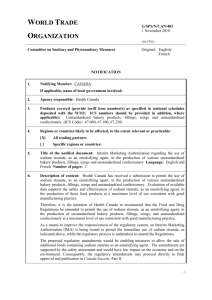Chemical Reaction
advertisement
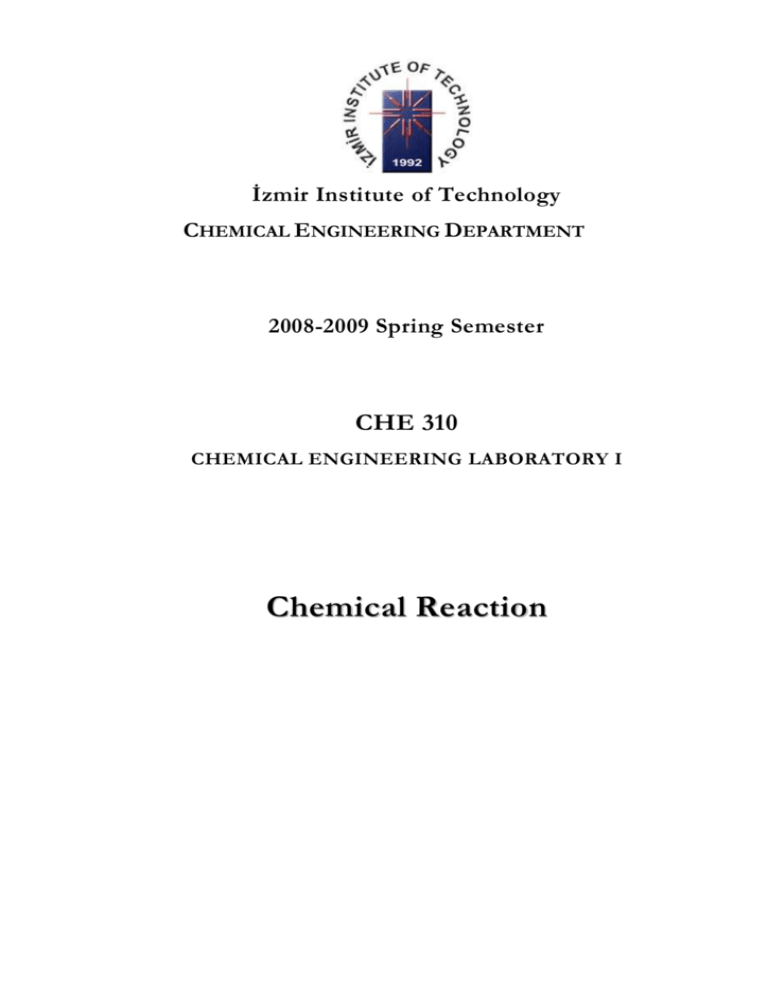
İzmir Institute of Technology CHEMICAL ENGINEERING DEPARTMENT 2008-2009 Spring Semester CHE 310 CHEMICAL ENGINEERING LABORATORY I Chemical Reaction CHEMICAL REACTION I. OBJECTIVE The objective of this experiment is to study a fast ionic chemical reaction of sodium soap with magnesium sulphate, calculate mass and energy balances for the process. II. PRINCIPLE and THEORY Chemical equation Under appropriate conditions, feed materials may be transformed into new and different materials which constitute different chemical species. If this occurs only by rearrangement or redistribution of the constituent atoms to form new molecules it is said that a chemical reaction has occurred. A chemical reaction can be shown in short form as a chemical equation; ∑ A i νi = 0 where; …………………………………………………...…..(1) A i is the substance i ν i is the stoichiometric coefficient ν i >0 for product ν i <0 for reactant Figure 1 shows the successive treatment steps in chemical process. Raw Materials Physical Chemical Physical Treatment Treatment Treatment Steps Steps Steps Products Recycle Figure 1: Typical Chemical Process Equilibrium Constant The equilibrium constant of a chemical reaction is; K= Π [A i]νi …………………………………………………..…………….(2) where; A i is the concentration of the component A i in mol/dm 3 Rate of Reaction The rate of change in number of moles of component Ai due to reaction is the 2 reaction rate. The rate of a chemical reaction: r = (-1/ ν 1 ) (d[A 1 ]/ dt)= (-1/ ν 2 ) (d[A 2 ]/dt) …………………(3) depends on the concentration of the reactants and temperature. ri= k [A 1 ]α [A2 ] β .................…………………………………………..(4) where; k is the rate constant A 1 and A 2 reactants α and β are the orders of the reaction with respect to A 1 and A 2. For simple reaction α = ν 1 and β = ν 2 As an example of chemical reaction water insoluble metal soap will be obtained from water soluble sodium soap and metal salt. 2(R-COONa) + MSO 4 (R-COO) 2 M + Na 2 SO 4 ..................................(5) The solubility of NaSt is vitally important in this reaction. Its solubility i s given in Figure 2. Solubility of NaSt increases with temperature above 60 C. At 70 C solubility is 4 %, at 72 C it is 15 %. This reaction should be carried out above 72 C to obtain highly concentrated NaSt solution and minimize water consumption. Figure 2. Krafft boundaries of long chain soaps in aqueous solution, Data NaSt (), NaAr (), NaBe () (Mul et al., 2000). 3 III. EXPERIMENTAL STUDY Chemicals Sodium stearate, magnesium sulphate and distilled water. Experimental Procedure - Before the experiment you should know which equipments, glassware and instruments will be used during the experiment. - Find the Material Safety Data Sheet (MSDS) for the chemicals. - What are the application areas of magnesium stearate? - What are the other production techniques of magnesium stearate? Production of MgSt 2 1. 2, 5 % (w) sodium soap is obtained by dissolving 5 gram sodium stearate in 200 ml of water at 70 o C. 2. Equivalent amount of magnesium sulphate is dissolved in 100 ml of water 3. Metal salt solution at 25°C is mixed with 200 ml of soap solution at 70°C and reaction is carried out at 80°C, according to equations below (complete the right hand-side of the equation) 2(C 17 H 35 COONa) (aq) + MgSO 4 .7H 2 O (aq) .........................................(6) 4. The precipitate obtained as a result of the reactions given above is left for a while to settle. 5. Solid and liquid phases are separated after precipitation, solid particles are removed by conventional filtration process, and filtrate conductivity is recorded. 6. In order to increase the purity magnesium stearate obtained, it is washed twice to remove by-product Na 2 SO 4 using 100 ml distilled water, and conductivity of the filtrate is recorded. 7. The wet solid, MgSt 2, taken from the filter is weighed and its weight is recorded. Characterization of MgSt 2 Before the characterization you should know the answers of the following questions: - What are the working principles of FTIR? - Why do we use? - What do we obtain at the end of the analysis? 4 8. 1 g of MgSt 2 is dried in a moisture analyser to determine its water content. Rest of MgSt 2 will be dried in circulating oven at 80 C. 9. Take IR spectrum of the dried product. IV. EVALUATION of EXPERIMENT 1. Explain why MgSt 2 precipitates when 200 ml sodium soap and 100 ml MgSO 4 . 7H 2 O solution are mixed. 2. Determine the weight of MgSt 2 produced and compare it with the theoretically calculated MgSt 2 amount from the Equation 6 3. Draw the block diagram of the process. 4. Perform the mass balance around the process. 5. Calculate the energy requirement for producing 1 kg magnesium stearate considering heat inputs for heating soap solution and for drying. 6. Write down the equilibrium expression for reaction equation 6 and solubility product equation for MgSt 2 (Chang, R.) 7. What is the rate expression for reaction equation 6? 8. How can you determine the purity of the MgSt 2 produced? 9. Find the characteristic IR peaks of magnesium stearate (MgSt 2 ) Acknowledgement: Author thanks Dr. D.Balköse for her helps in preparing this manual. V. REFERENCES Levenspiel O., “Chemical Reaction Engineering”, 2 nd Edition, John Wiley & Sons pp 357-376, Toronto, 1972 Chang R., “Chemistry”, 5 th Edition, McGraw-Hill, pp. 125-135, Princeton Mul M. N. G., Davis H. T., Evans D. F., Bhave A. V., and Wagner J. R., “Solution phase behavior and solid phase structure of long chain sodium soap mixtures”, Langmuir, 16, 8276-8284, 2000. 5

